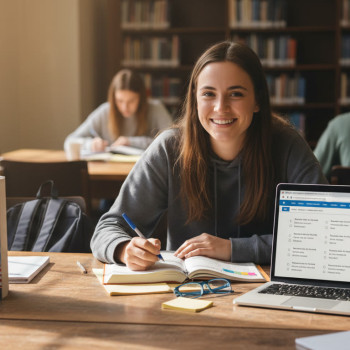Introduction: Why This Question Matters More Than You Think
If you’ve ever sat at your desk wondering whether to hire a tutor or go it alone, you’re not alone. Choosing tutoring versus self-study is one of the most consequential decisions an AP student makes—because it influences not just test day, but how you learn, retain, and apply material in college and beyond.
This guide walks through the decision subject by subject so you can choose the smartest, most efficient path for your strengths, timeline, and goals. Along the way you’ll find concrete examples, realistic study schedules, sample session plans, and a simple decision framework you can use for any AP course. You’ll also see where Sparkl’s personalized tutoring (1-on-1 guidance, tailored study plans, expert tutors, and AI-driven insights) can slot in naturally if you decide tutoring is the right move.

How to Decide: A Practical Framework
Before diving into individual subjects, use this quick checklist. It helps you evaluate whether tutoring or self-study is the better choice for you.
- Baseline skill level: Have you taken previous coursework in the subject? Are fundamentals strong?
- Target score: Are you aiming for a 3 (college credit less likely), 4, or 5 (highest mastery)?
- Time until exam: How many months/weeks do you have?
- Learning style: Do you thrive with guided feedback, or do you prefer independent discovery?
- Resources available: Textbooks, AP Classroom, practice exams, and possible tutors.
- Cost-benefit balance: Can you invest in tutoring? Would the potential score increase justify the cost?
Quick rule of thumb: if you have limited time (<4 months), weak fundamentals, or a target score of 4–5, tutoring often multiplies effort most efficiently. If you have 6+ months, strong fundamentals, and discipline, self-study can be highly effective—especially when bolstered by targeted resources.
Subject-by-Subject Guide
Below we rate each major AP subject on three dimensions: Difficulty to Self-Study (Low/Medium/High), When Tutoring Helps Most, and Suggested Strategy. This is a practical, experience-based synthesis—use it to make subject-specific choices.
AP Calculus AB and BC
Difficulty to Self-Study: Medium to High. Calculus requires mathematical maturity—procedural fluency plus conceptual understanding.
When Tutoring Helps Most: If your algebra and trig foundations are shaky, or your goal is a 4–5 in a short timeline. BC students often benefit from a tutor to navigate parametric/vector/series material efficiently.
Suggested Strategy:
- Self-study route: follow a 6–9 month plan that alternates concept weeks with problem weeks. Use AP practice exams monthly.
- Tutoring route: weekly 1-hour sessions for concept review + weekly problem sets. Sparkl’s personalized tutoring can craft a tailored roadmap—focusing on weak areas (e.g., integration techniques or series convergence) and providing targeted practice sets and AI-driven progress checks.
AP Physics 1, 2, and C
Difficulty to Self-Study: High (Physics C especially because of calculus). These exams test problem-solving and lab reasoning.
When Tutoring Helps Most: Almost always helpful if you want a 4–5, need lab/experimental design practice, or struggle to translate real-world scenarios into equations.
Suggested Strategy:
- Practice is king—do lots of past free-response problems and simulated lab questions.
- Tutors can model problem approaches, correct misconceptions in real time, and provide experiment-design walkthroughs. Sparkl’s expert tutors can simulate lab-style questions and give immediate feedback on reasoning and setup.
AP Chemistry
Difficulty to Self-Study: High. Stoichiometry, thermodynamics, and equilibrium need conceptual clarity and lots of practice.
When Tutoring Helps Most: If you’re uncomfortable with chemical math or need help with lab analysis and periodic trends.
Suggested Strategy:
- Combine a concept-first approach with timed problem sets.
- Tutoring is especially valuable for working through free-response problems and for improving accuracy under time pressure.
AP Biology
Difficulty to Self-Study: Medium. Heavy on content memorization plus interpretive skills for data and experiments.
When Tutoring Helps Most: If you struggle with organizing the huge content load, or need help with analysis of experimental data and graph interpretation.
Suggested Strategy:
- Organize study by systems and practice with multiple choice sets and free-response rubrics.
- Sparkl’s tutoring can help build personalized flashcard sets and data-analysis practice tailored to your weak units (e.g., cellular respiration vs. genetics).
AP English Language and Composition; AP English Literature
Difficulty to Self-Study: Low to Medium. Success depends on reading habits and essay practice more than memorization.
When Tutoring Helps Most: If you need help with thesis construction, rhetorical analysis, or consistent essay scores. For Literature, a tutor can help unpack texts and themes quickly.
Suggested Strategy:
- Self-study can be effective—daily close reading + weekly timed essays + review of sample high-scoring responses.
- Tutoring is useful for individualized feedback on essays; a tutor who marks essays and guides revision can accelerate improvement dramatically.
AP US History (APUSH), European History, World History
Difficulty to Self-Study: Medium. These courses emphasize timelines, causation, and evidence-based essays.
When Tutoring Helps Most: If you need help synthesizing eras, forming comparative arguments, or crafting DBQ/LEQ strategies.
Suggested Strategy:
- Create a timeline and theme matrix. Practice DBQs and LEQs monthly. Self-study can work if you’re disciplined.
- Tutoring is especially effective for practicing thesis-driven essays and receiving targeted feedback on writing structure and use of evidence. Sparkl’s tutors can provide rubrics, model outlines, and scoring-aligned edits.
AP Computer Science A
Difficulty to Self-Study: Medium. If you’re comfortable with logic and basic programming, self-study is often successful.
When Tutoring Helps Most: If you’re new to coding or aiming for a 5 in one semester.
Suggested Strategy:
- Code daily small projects, practice past AP coding questions, and understand OOP patterns.
- Tutors are great for live debugging sessions and for exposing common pitfalls. Sparkl’s 1-on-1 tutoring can guide you through a sequence of projects that directly mirror AP exam tasks.
AP Statistics
Difficulty to Self-Study: Medium. The conceptual vocabulary and calculator/stat software skills matter.
When Tutoring Helps Most: For interpretation of results, sampling concepts, and hypothesis testing mistakes.
Suggested Strategy:
- Work through real datasets and past exam questions. Focus on interpretation over computation.
- Tutors can help clarify when to use which test, how to set up a hypothesis, and how to write clear conclusions under time pressure.
Comparative Table: Quick Look Across Popular AP Subjects
| AP Subject | Self-Study Feasibility | When to Choose Tutoring | Core Self-Study Strategy |
|---|---|---|---|
| Calculus AB/BC | Medium | Weak algebra/trig, short timeline, 4–5 goal | Concept weeks + problem weeks; monthly practice exams |
| Physics 1/2/C | Low to Medium | Lab reasoning, calculus use, problem transfer gaps | Heavy practice on free-response and lab questions |
| Chemistry | Low | Struggling with problem setup or chemical math | Timed problem sets and conceptual mapping |
| Biology | Medium | Difficulty organizing content or analyzing experiments | System-based review and data interpretation practice |
| English Lang/Lit | High | Need essay feedback or rhetorical skills | Daily reading + weekly timed essays with feedback |
| US History | Medium | DBQ/LEQ strategy weaknesses | Timeline matrix + monthly DBQ practice |
| Computer Science A | Medium | New coders or rapid timeline | Daily coding practice + project-based learning |
| Statistics | Medium | Interpreting tests and real datasets | Practice with real-world data and clear writeups |
How to Blend Tutoring and Self-Study: A Hybrid Roadmap
You don’t have to pick one side exclusively. Many successful students use a hybrid approach: self-study as the backbone and tutoring as a precision tool. Here’s a flexible blueprint—pick the one that fits your calendar.
6-Month Hybrid Plan (Typical Spring Exam Cycle)
- Months 6–4: Self-study foundation—read course framework, complete topic-based problem sets, build flashcards.
- Months 4–2: Add biweekly tutoring sessions focused on weak units and free-response strategy. Begin full-length practice exams monthly.
- Month 2–0: Weekly tutoring for timed sections, error analysis, and targeted drills. Full-length practice exams every 10–14 days. Final week: light review and exam logistics.
This model uses tutoring efficiently: the student builds independent habits and brings specific gaps to each tutoring session for rapid improvement. Sparkl’s personalized tutoring works well here—tutors can prepare homework aligned to the student’s past mistakes and use AI-driven insights to track progress.
Sample Weekly Plans
Below are two sample weeks—one self-study-heavy and one tutor-focused—so you can visualize the difference.
Self-Study-Heavy Week (AP Calculus AB)
- Monday: 60 minutes concept review (integration by parts), 30 minutes targeted practice
- Tuesday: 90 minutes problem set (mixed chapter), review errors for 30 minutes
- Wednesday: 45 minutes AP multiple-choice bank, 30 minutes Anki flashcards
- Thursday: 90 minutes practice free-response question, self-score using rubrics
- Friday: Off or light review (30 minutes)
- Weekend: 2–3 hours full practice set or peer study group
Tutor-Focused Week (AP Chemistry)
- Monday: Tutor session 60 minutes—cover Hess’s law problems and lab reasoning
- Tuesday: 60 minutes targeted practice assigned by tutor
- Wednesday: 45 minutes multiple-choice practice
- Thursday: 60 minutes review of tutor feedback and corrections
- Friday: 30 minutes flashcard review
- Weekend: 2 hours timed practice FRQ and self-score
How to Measure Progress: Metrics That Actually Mean Something
Stop obsessing over raw hours. Track metrics that show learning and exam readiness:
- Accuracy by Topic: Percent correct on problem sets per unit.
- Timed Section Score: Simulated score on the timed multiple-choice blocks.
- Free-Response Rubric Success: Number of rubric points consistently achieved.
- Transfer Rate: Can you apply one concept to a different context (e.g., use kinematics in an energy problem)?
- Error Type Tracking: Categorize mistakes (careless, concept, strategy, arithmetic).
Use short, weekly check-ins to decide whether to increase tutoring sessions, change resources, or continue the current plan. If you’re using tutoring, ask for measurable goals each month—better alignment means better results.
Cost and Time Considerations: Be Realistic
Tutoring costs vary widely; the right question is ROI. If a tutor helps you move a score from a 3 to a 4 or 4 to a 5 in a subject where college credit or placement matters, that can pay off in tuition savings or better class placement. If budget is tight, prioritize tutoring for:
- High-stakes subjects where you need a 4–5 for credit or major prerequisites (Calculus, Physics C, Chemistry).
- Areas where you’ve plateaued despite self-study.
Time-wise: a focused 1-hour weekly tutor session plus 3–6 hours of independent practice can beat 10+ hours of unfocused solo study. That’s why many students choose a hybrid approach.
Real-World Examples: Two Student Profiles
Case 1 — Maya: AP Biology and AP Chemistry
Maya is a junior with strong biology instincts but weaker chemistry math skills. She self-studied Biology using AP Classroom and practice FRQs, scoring steady 85–90% on content quizzes. Chemistry felt different—she made repeated algebraic errors and could not translate lab descriptions into calculations. She chose Sparkl’s targeted tutoring for Chemistry: weekly 1-hour sessions focusing on stoichiometry, equilibrium calculations, and lab-style problems, plus monthly full practice exams. Result: her timed problem accuracy improved, and her free-response structure tightened—moving her predicted Chemistry score from a 3 to a projected 4.
Case 2 — Eric: AP Calculus BC and AP Computer Science A
Eric was solid in math fundamentals and loved coding. He self-studied CS A by building small projects and solving past coding problems; he did weekly peer code reviews. For Calculus BC, he used self-study until an error pattern surfaced on series convergence problems. He booked biweekly tutoring for six weeks with a focus on series and polar coordinates. The targeted sessions helped him close the gap quickly while he continued independent practice for everything else.
How to Choose a Tutor (If You Decide to Go That Route)
Not all tutors are created equal. Use this checklist when interviewing tutors:
- Do they have direct AP experience—scoring FRQs, teaching the course, or acing the exam themselves?
- Can they show a sample plan for your subject and a month-by-month roadmap?
- Do they offer measurable outcomes and error-tracking?
- How do they give feedback—written corrections, recorded walkthroughs, or live annotation?
- Do they integrate exam-style practice and timed conditions into sessions?
Sparkl’s tutoring model emphasizes expert tutors, personalized plans, and AI-driven insights that identify weak spots faster—helpful signals when you want a systematic, accountable approach.
Study Tools and Resources That Complement Either Path
Whichever route you choose, these study tools are universally helpful:
- AP Classroom topic questions and progress checks for your specific course.
- Released AP free-response questions and sample scoring guidelines—practice and self-score with rubrics.
- Timed practice exams under exam-like conditions (simulate breaks, timing, and calculator policy).
- Active recall tools (Anki or similar) for dense content like Biology or History facts.
- Problem banks and concept video libraries for step-by-step walkthroughs.
Final Checklist: Make a Confident Decision
Answer these quick prompts to decide today:
- Do I have fewer than 4 months to prepare? If yes, tutoring likely helps.
- Is my goal a 4 or 5 for college credit or placement? If yes, prioritize tutoring or a hybrid plan for tougher subjects.
- Do I consistently struggle with the same error types (conceptual vs arithmetic)? If yes, targeted tutoring can correct patterns faster.
- Can I commit to a disciplined self-study schedule (4–10 hours weekly) with regular practice exams? If yes, self-study is viable for many subjects.
Closing Thoughts: Make the Choice That Keeps You Learning
There’s no single right answer. Some students thrive on the independence and pacing of self-study; others benefit from the accountability and expertise a tutor brings. The smartest plan is one that’s realistic about time, honest about weaknesses, and flexible enough to combine strategies.
Remember: a tutor is a force-multiplier, not a magic wand. Whether you study alone, with a tutor, or in a hybrid model, commit to regular feedback loops: weekly performance checks, monthly full exams, and intentional practice on your weakest topics. If you want targeted, measurable tutoring with tailored study plans and data-driven insights, Sparkl’s personalized tutoring can fit naturally into that loop—helping you maximize progress, focus every hour you study, and enter exam day calm and prepared.

One Last Practical Tip
Start small and iterate. Book a trial tutoring session for one difficult unit, or commit to one focused month of self-study with a clear rubric. Compare progress after four weeks and adjust. Your AP journey is a sequence of decisions—make each one based on data, not panic.
Good luck—and study smart.
Keep a growth mindset, track your mistakes, and choose the path that helps you learn best. The AP exam is a milestone; how you prepare will shape the skills you carry into college. Whether you self-study, tutor, or blend both—make the plan personal, intentional, and measurable.


















No Comments
Leave a comment Cancel